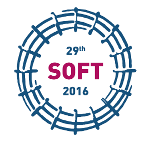Speaker
Roberto Ambrosino
(Engineering department)
Description
The European roadmap to the realisation of fusion energy has identified a number of technical challenges and defined eight different missions to face them. Mission 2 ‘Heat-exhaust systems’ addresses the challenge of reducing the heat load on the divertor targets.
Divertor Tokamak Test (DTT) facility [1]-[2] has been launched to investigate alternative power exhaust solutions for DEMO. This tokamak should be capable of hosting scaled experiments integrating most of the possible aspects of the DEMO power and particle exhaust. DTT should retain the possibility to test different divertor magnetic configurations, liquid metal divertor targets, and other possible solutions for the power exhaust problem.
In this paper we investigate the feasibility and the costs of conventional and alternative magnetic configurations on DTT. We have developed Single Null, SnowFlake, Quasi SnowFlake and Double Null configurations optimizing the plasma shape and the currents on the PF coils. The magnetic configurations feature the main characteristic of each alternative divertor concept with a constraint on the plasma-wall distance and on the plasma elongation. The feasibility of the configurations is evaluated in terms of maximum vertical force and current density on the PF coils at the start of the current flat top (SOF) and at the end of the flat top (EOF). The Nb3Sn central solenoid (CS) is capable to operate at 13.2 T while the poloidal field (PF) coils work in a not-challenging range of parameters for the superconducting NbTi material.
The alternative configurations are compared in terms of various parameters such as plasma current, plasma volume, the flat-top magnetic flux swing and PF current request.
[1] A. Pizzuto (Ed.), DTT - Divertor Tokamak Test facility - Project Proposal, ENEA, July 2015, ISBN: 978-88-8286-318-0, http://fsn-fusphy.frascati.enea.it/DTT/downloads/Report/DTT_ProjectProposal_July2015.pdf
[2] R. Albanese et al., ‘Design and definition of a Divertor Tokamak Test facility’, SOFT 2016
Co-authors
Flavio Crisanti
(ENEA, via Enrico Fermi 45, I-00044, Frascati, Italy)
Giuseppe Calabro
(ENEA, via Enrico Fermi 45, I-00044, Frascati, Italy)
Raffaele Albanese
(DIETI, University of Naples Federico II, via Claudio 21, I-80125, Napoli, Italy;CREATE-ENEA, via Claudio 21, I-80125, Napoli, Italy)
Roberto Ambrosino
(Engineering department, University of Naples Parthenope, Napoli, Italy;CREATE-ENEA, via Claudio 21, I-80125, Napoli, Italy)

